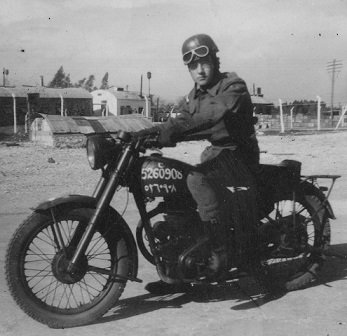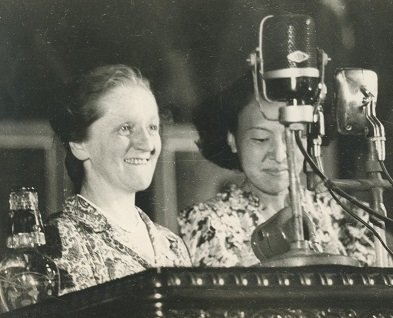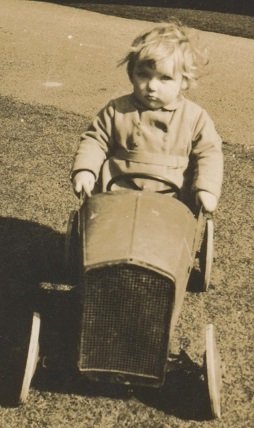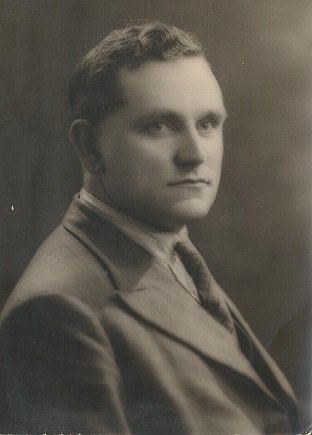One hundred and forty-three years of information about my family were contained in the Ancestor Chest. That’s the time between the oldest unambiguously dated document it contained (1867) and the year it ceased to act as clearing house for precious but hard-to-file stuff (2010).
During that period, there were ups and downs. The captured episodes most obviously intriguing to posterity were the international adventures:
My father, Reg Baker, stationed in Palestine with the British Army between 1946 and 1948, just as the state of Israel was created (1948), and the associated violence was breaking out. While there, Dad acquired a ‘little box brownie’ camera, resulting in an extensive photographic record replete with guns, motorbikes, warships, snakes, and the aftermath of terrorist attacks.
My grandfather, Peter Marsh, in the USSR around 1950. He’s pictured in locations including the Moscow Metro, Dnipropetrovsk (central Ukraine), Tashkent (in what’s now Uzbekistan), and a collective farm I couldn’t locate. There’s smiling photos of him with military-garbed Soviet officers, and grinning shots beneath flag-rimmed portraits of Joseph Stalin.
My grandmother, Bess Marsh, visiting North Korea in 1953, right after the Korean War and when it was still possible to believe North Korea’s system wasn’t among the most wrong-headed in modern history. There’s images of Bess in and around Pyongyang: on the podium at a women’s conference having arrived via East Berlin, Warsaw, Moscow and Siberia, and smiling on the runway before a twin-propped aeroplane daubed in Korean letters, holding a bouquet of flowers.


Markers & Observations
- My ancestors who passed away before 1925 were generally done-in by afflictions from which hardly anyone now dies. Between 1925 and 1970 it was overwhelmingly heart disease, with one notable case of emphysema (i.e. smoking). Beginning from the 1970s, some of them started to make it past 80 and die from actual old age. After that, it’s cancer. The history of twentieth-century mortality is writ clear the deaths of my ancestors.
- My mother’s family were affluent from before 1900, and the first (photographically) well-recorded life arc began in the 1857. My father’s family were working class, and the first such arc begins in 1926 – sixty years and two generations later. There’s 50 photos of Mum before the age of 18. Of Dad there’s just two.
- The nineteenth-century photos were all taken in studios by professionals. Without exception, they’re sumptuously shot, expertly posed, and flattering to the subject. With the appearance of personal cameras, around 1915, natural poses follow, but average photo quality falls a lot.
- Photographic art flowered on occasion during the twentieth century. In the 1970s, when Dad was a recently ex-professional photographer with a newly acquired family, there’s shots of my sister and I rivalling anything on Facebook. From 1937-42, there’s a gorgeous and poignant set of images of my mother and her siblings as toddlers – riding bikes, having grumps, playing in sandboxes, and wearing their adorable 1930s kiddy gear. I don’t know who took them.
- During the 1980s, when we had little money, a rubbish camera, and my sister and I controlled it, the photo volume is high, but quality is particularly poor. Sometime later, as digital photography takes over, photo quality rises suddenly, and precipitously. The digital pictures from my Jolly Pilgrim adventure, of 2005-07, are better than almost anything in the archive between 1980 and 2000.

Ancestors of Interest
Certain ancestors provoked strong instinctual fascination in me. For example: my great grandmother, Elizabeth Marsh, and great grandfather, John Donnelly, (her son married his daughter). This is despite their lives being distant from my own by 4-5 decades and two degrees of separation, and my understanding of their personalities and achievements being tenuous.
I concluded that my fascination with them was because I could sense Elizabeth and John’s presence in the tree of life around me. I met children of both (in their old age), and have a rich understanding of the life stories of their other children. For John, I’ve seen the documents preserved in his strongbox. . For both, I’ve seen all the photographs. Triangulating those varied sources yields a substantive sense of what Elizabeth and John must have been like (Elizabeth’s kids had a puritanical streak, John’s were musical), the mark they left on the world, and how their lives shaped mine.
A generation further back: the hard data trends towards zero and my antenna aren’t sensitive enough to yield sense through the white noise. So the meaning of the lives of my ancestors beyond that (from my point of view) becomes merely theoretical – names on a family tree; recent iterations in the circle of life of whom I have no detailed comprehension.
The Poon Analysis
I’m on Quora, where users ask and answer questions. A year back, I came across an outstandingly insightful answer, by a Canadian clothing designer called Thelonius Poon.
Mr Poon asserts that, in life, the little things add-up to the big things: while the ultimate differences in the life experiences of different people are extremely wide, the day-to-day differences are quite small. For example, in school, the most important dates are the exams, which are less than 5% of one’s time there. An extra hour per day studying during the 95% is decisive in the critical 5%.
Falling in love takes time and is gradual. Working towards a dream job takes time and is gradual. Starting a successful business takes time and is gradual. Friends drifting apart is gradual. Parents dying is gradual. Losing one’s way is gradual - people don’t misplace their souls in a day, they misplace them a little at a time, a day at a time.
If one accepts Mr Poon’s analysis, the question that leads from it is: what kind of creature are you currently morphing into? What person, for better or worse, will you have become five years from now? And how do you feel about that?
After building the archive, I have two data sets against which to cross-reference those questions:
- A series of images showing how my ancestors changed throughout their lives: from toddlerhood and youth, to adulthood and old age.
- A fairly good, high-level, sense of what became of those people; of how their stories played out and concluded.
This is all rather enlightening when considering one’s own life options. Clear lessons emerge: life is a marathon; you have a certain role now, but you’ll have a different role in 5, 10 and 20 years. So stay in shape, stay relevant and stay useful. Make the most of every unforgiving minute. Don’t die of a heart attack in your 50s when your family needs you. And label your photos.

To Look Forward: Look Back
I found building the archive both educational and rewarding, for several reasons.
First, there’s the satisfaction of delivering a creative project. Devising solutions to technical problems. The fun of writing these reflections.
Second, there’s the gratification of organisation. Taking a disorganised jumble and turning it into something orderly, systemized and searchable. Capturing the extractable value of a 140-year snapshot of family life and marking it down in a form junior family members – and posterity – might review, and learn from.
Third, I now personally have a much more granular understanding of my recent ancestors. For those captured in the photos, I’ve got a feel for where they were in their life’s journey during the parts of the nineteenth and twentieth centuries in which they lived, and where they were in relation to other family members with whom they crossed paths.
Fourth, looking at all those photos forced me to focus on the physical reality of the lives of my forebears. There’s the evolving roles each played (from girlchild, to maiden, mother, and elder; or from cheeky lad, via Jack the Lad, all the way to greybeard) and the extent to which the human world changed between, for example, when I played-out my youthful prime (in the 2000s), when my mother was at that stage (in the 1960s), and when my grandmother undertook that role (in the 1930s). Big changes.
Finally, seeing oneself in the context of that chain of lifetimes is a reminder that we’re all part of something larger than ourselves. Just because those ancestors are now dust, doesn’t make the fact of their lives less salient, significant or wonderful. A thing of beauty is a joy forever. We’re all fairy tales told by our ancestors, and we’re on a journey together, into the future. Immortality – real immortality, which resonates with how the universe really is – comes from being a part of that greater whole.
by word, by writing, by monument, by manners,
by way of life, by newly shaped environment...
by so much that a thousand words would not exhaust it,
I say, the Self is not so much linked with what happened to its ancestors,
it is not so much the product … of all that,
but rather … the same thing as all that:
the strict, direct continuation of it ...
― Erwin Schrödinger, My View of the World
More from me:
• My book (UK)
• My book (US)
• My website
All the photos from the Ancestor Chest:
• Marsh-Donnelly, 1867-1970
• Baker, 1910-1970
Welcome thejollypilgrim!
eSteem is the application that improves your experience on Steem. You have full control over your data and content, unlike some apps we don't use our users to promote our application or services.
We have Mobile application for Android and iOS users. We also have developed Surfer Desktop application that helps you to gain new followers and stay connected with your friends, unique features - notifications, bookmarks, favorites, drafts, and more.
We reward our users with encouragement upvotes as well as monthly giveaways rewarding Spotlight top users and active Discord users.
Learn more: https://esteem.app
Join our discord: https://discord.gg/8eHupPq
Downvoting a post can decrease pending rewards and make it less visible. Common reasons:
Submit
Welcome to the community!
Download the Partiko app below to start earning Partiko points which can be converted into Steem.
Start here - https://partiko.app/referral/jmehta
Downvoting a post can decrease pending rewards and make it less visible. Common reasons:
Submit
Hello, welcome to Steem. I hope you would enjoy it here as much as I do.
I will recommend you to use the partiko mobile app for an amazing experience on Steem.
Download the app with my referral link https://partiko.app/referral/akomoajong
Once you download the app and login, I will delegate 15SP to help your journey on Steem for a week.
Posted using Partiko Android
Downvoting a post can decrease pending rewards and make it less visible. Common reasons:
Submit
Welcome to steemit @thejollypilgrim.
Welcome the new steemians. Have a great day!
Downvoting a post can decrease pending rewards and make it less visible. Common reasons:
Submit
Congratulations @thejollypilgrim! You have completed the following achievement on the Steem blockchain and have been rewarded with new badge(s) :
Click here to view your Board
If you no longer want to receive notifications, reply to this comment with the word
STOPDo not miss the last post from @steemitboard:
Downvoting a post can decrease pending rewards and make it less visible. Common reasons:
Submit
Hello @thejollypilgrim! This is a friendly reminder that you have 3000 Partiko Points unclaimed in your Partiko account!
Partiko is a fast and beautiful mobile app for Steem, and it’s the most popular Steem mobile app out there! Download Partiko using the link below and login using SteemConnect to claim your 3000 Partiko points! You can easily convert them into Steem token!
https://partiko.app/referral/partiko
Downvoting a post can decrease pending rewards and make it less visible. Common reasons:
Submit
Congratulations @thejollypilgrim! You received a personal award!
You can view your badges on your Steem Board and compare to others on the Steem Ranking
Vote for @Steemitboard as a witness to get one more award and increased upvotes!
Downvoting a post can decrease pending rewards and make it less visible. Common reasons:
Submit